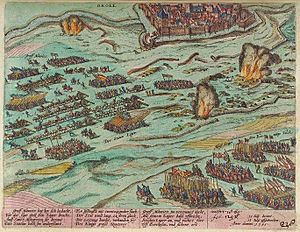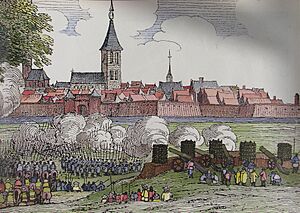Siege of Groenlo (1595) facts for kids
Quick facts for kids Siege of Groenlo (1595) |
|||||||
|---|---|---|---|---|---|---|---|
| Part of the Eighty Years' War & the Anglo–Spanish War | |||||||
 View of the siege of Groenlo in 1595 |
|||||||
|
|||||||
| Belligerents | |||||||
| Commanders and leaders | |||||||
(Spanish Tercios) (In Groenlo) |
|||||||
| Strength | |||||||
| 6,000 infantry 200-300 cavalry 16 artillery pieces |
(Spanish Tercios) 7,000 infantry 1,300 cavalry (In Groenlo) 600 infantry |
||||||
The Siege of Groenlo in 1595 was a short battle during the Eighty Years' War. This war was fought between the Dutch Republic and the Spanish Empire. The Dutch forces, led by Maurice of Nassau, tried to capture the town of Groenlo from the Spanish.
The siege lasted from July 14 to July 24, 1595. It ended when a Spanish army, led by Cristóbal de Mondragón, arrived to help Groenlo. Maurice of Nassau then had to retreat. Two years later, in 1597, Maurice tried again and successfully captured Groenlo.
Contents
Why Groenlo Was Important
Groenlo, also known as Grol back then, was a small but important town. It was a strong fort located near the eastern border of the Dutch Republic.
A Key Trading Spot
Groenlo was a vital link for trade. It connected Dutch cities like Deventer and Zutphen to the Holy Roman Empire. These Dutch cities were part of the Hanseatic League, a group of trading cities.
Strong Defenses
The town was in a difficult area to travel through. Because of this, Groenlo had many strong defenses. Its medieval brick walls were improved over time. By 1595, the town had moats (water-filled ditches), bastions (strong parts of the wall sticking out), and cannons.
Spanish Control
In 1580, Spanish troops took control of Groenlo. This happened after they had already taken over other nearby areas. From 1581 onwards, a Spanish army stayed in the city to guard it.
Maurice's Plan to Attack
Maurice of Orange was a leader for the Dutch side. He was the stadtholder (a kind of governor) for several Dutch regions. He started a plan to take back Dutch forts and cities from the Spanish.
Previous Victories
Between 1590 and 1593, Maurice had some big wins. He managed to capture important cities like Breda, Deventer, and Zutphen. These victories made him confident.
Planning the Twente Campaign
In 1594, Maurice began to plan a new campaign. He wanted to take cities in a region called Twente. To start this plan, he decided to attack Groenlo first.
Advice from William Louis
Maurice's nephew, William Louis, Count of Nassau-Dillenburg, was a military advisor. He thought Groenlo's defenses were too strong. William Louis suggested attacking Lingen instead. However, Maurice decided to stick with his plan for Groenlo.
Getting Ready for Battle
Maurice faced challenges in finding enough money and soldiers. Because of this, his campaign into Twente did not start until 1595. That's when the siege of Groenlo finally began.
The Siege Begins
The siege started on July 14, 1595. Maurice arrived at Groenlo with a large force. He had 6,000 foot soldiers, some cavalry, and sixteen cannons.
Delayed Arrival
Their arrival was a bit delayed. One of their large cannons got stuck near a town called Vragender. This slowed down Maurice's army.
Spanish Commander's Actions
The Spanish governor of Groenlo was Jan van Stirum. When he saw Maurice's army coming, he quickly called his troops back to Groenlo. These troops had been stationed in Goor. On their way back, Maurice's forces ambushed them. At least forty Spanish soldiers were killed.
Building Camps and Trenches
The next day, Maurice started building a base camp. It was located to the west of Groenlo. His soldiers also began digging several trenches. William Louis helped Maurice and placed his troops to the east of the town.
Demand for Surrender
The camps and trenches were finished within a week. Maurice then sent a message to Jan van Stirum. He demanded that Groenlo surrender. Maurice even fired three warning shots with his cannons.
Stirum's Refusal
Jan van Stirum sent a letter back. He refused to give up. He wrote that he would defend Groenlo "for God and King until his last drop of blood." Stirum also used his own cannons to fire at Maurice's soldiers. He sent a message asking for help from his commanders.
Mondragón Arrives
To help Stirum, a very old general was sent. He was 81-year-old Cristóbal de Mondragón. People called him 'the good old Mondragon'. He was the governor of Antwerp.
Mondragón's Army
Mondragón arrived with a large army. He had 7,000 foot soldiers and 1,300 cavalry. His main order was to keep Groenlo out of Dutch hands. But Mondragón also wanted to fight Maurice's army. He hoped to stop Maurice's entire campaign into Twente.
Maurice's Reaction
Maurice heard about Mondragón's approaching army on July 21. He quickly worked to get his battlefield ready. He finished the trenches that same day. Maurice also ordered some bridges to be taken apart.
Ending the Siege
Maurice knew Mondragón's army was a big threat. On July 24, he started firing heavily at Groenlo. He demanded that the town surrender right away. After talking it over with William Louis, Maurice decided to stop the siege the next day. He was worried that Mondragón's troops would attack from behind and surround his army.
What Happened Next
Maurice had to leave quickly. He didn't have enough wagons to carry everything. So, he burned his camp sites and any heavy equipment he couldn't move.
Moving the Troops
Maurice led his troops through Borculo and Ulft to Zelhem. The plan to attack Twente was called off for a while. Instead, Maurice used his soldiers to fight groups of bandits in the area.
Artillery and Future Plans
The cannons were sent to the city of Doesburg, which the Dutch controlled. Maurice put his Twente campaign on hold until 1597. In that year, he returned to Groenlo and successfully captured it.


